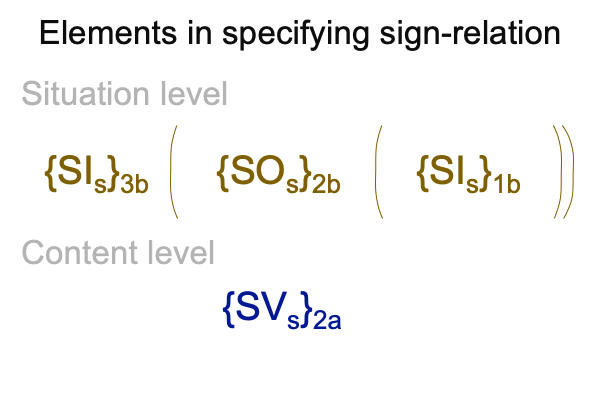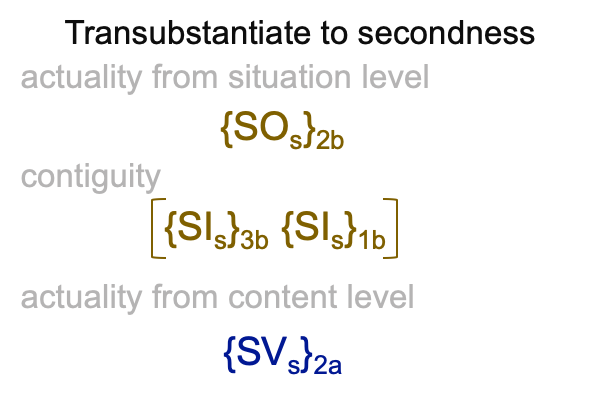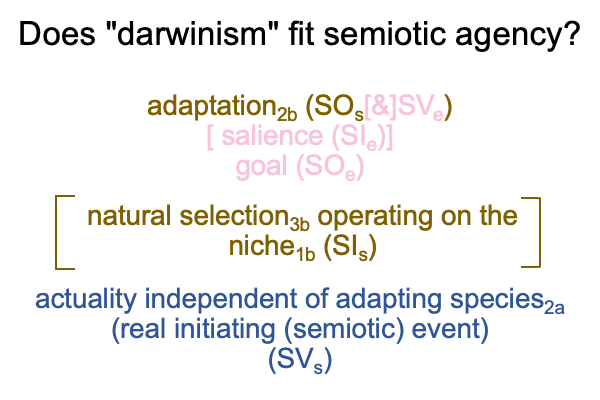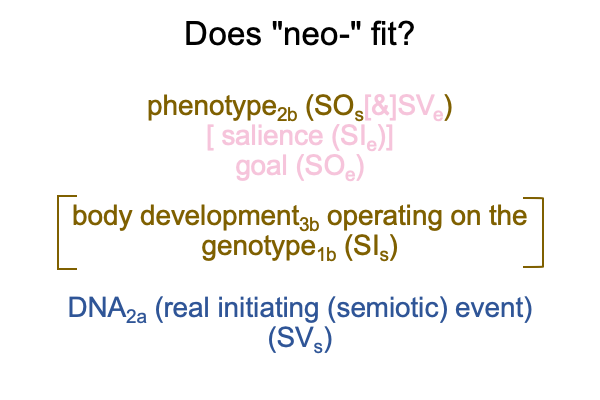1238 Natural historians say, “Consider the adaptation2H.”
Geneticists say, “Consider the phenotype2V.”
The two-level interscopes of adaptation2b and of phenotype2b have one thing in common.
Both express all the elements of the specifying sign-relation.

1239 For the natural historian, an actuality independent of the adapting species2a (SVs) stands for an adaptation2b(SOs) in regards to natural selection3b operating on a niche1b (SIs).
For the geneticist, DNA2a (SVs) stands for a phenotype2b (SOs) in regards to body development3b operating on the genotype1b (SIs).
1240 Now, I wonder whether I can repeat the same trick as the one performed at the very start of Semiotic Agency (N).
1241 The above figure expresses two styles of triadic relations, the specifying sign-relation and the two-level interscope. There are two real elements, the content- and situation-level actualities, and they look like a dyad. The situation level holds one real element, which I associate to matter (or esse_ce, being [substantiating]). The content level holds the other real element, which I associate to form (or essence, [substantiated] being}.
1242 Why the associations?
That is how the actualities appear in the above figure.
Content-level form (SVs) stands for situation-level matter (SOs). This is like the appearance of a shape (SVs) standing for the presence of matter (SOs) in regards to a situation-level normal context3b operating on the possibility of ‘situating content’1b (SIs). Or, this is like a sensation2a (SVs) standing for a perception2b (SOs) in the normal context of what it2ameans to me3b operating on the potential1b of situating content2a (SIs).
1243 What else do I see?
I see the situation-level normal context3b and its potential1b folding into the contiguity between matter (SOs) and form(SVs).
Here is a picture.

Surely, this diagram associates to the S&T noumenal overlay, but separately for adaptation2b and phenotype2b.
1244 Adaptation2b looks like information2b.

1245 Phenotype also looks like information2b.

1246 Both these figures represent incomplete pictures of semiotic agency, because there are no exemplar sign-relations.
Both tell me how incomplete neodarwinism is, as a model for biological systems.
Natural historians may be satisfied with the way that darwinism fits.
Geneticists may be satisfied with the way that the “neo” of neodarwinism fits.
1247 Why don’t most biologists want to talk about “niche” or “genotype”?
Well, the real elements, SVs and SOs, are obvious.
How does one model what needs to be accounted for (the contiguity, SIs) using observations and measurements of the phenomena of the real elements (SVs and SOs)?
Well, natural historians and geneticists are doing research everyday. They encounter this issue. But, they do not have a complete image of semiotic agency that directs the inquirer.
They do not have an exemplar sign-relation.
